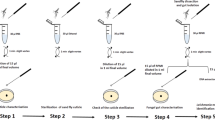Abstract
From body of 300 flies (Musca domestica andSarcophaga carnaria) captured in open rural the authors succeed in isolating 4 times (1.33%) telluric dermatophytes: 3 timesMicrosporum canis and 1 time simultaneouslyMicrosporum gypseum andTrichophyton terrestre.
Similar content being viewed by others
References
Gyp, L. & S. A. Svenson (1968) Can flies cause the spread of dermatophytosis? Acta Derm. Ven. (Stockholm) 48: 26.
Kamiszek, F. (1969) Investigations on the role of M. ovinus in the transmission of pathogenic fungi. Medyc. Veter. 25: 163.
Koch, H. A. (1964) Zur Oekologie von Trichophyton verrucosum Bodin 1913 Vortr. Intern. Congr. Mykol. Warschau. 75.
Koch, H. A. (1964) Fliegen als Ueberträger von Dermathphyten. Der Hautartzt. 15: 365.
Richard, S. L. (1963) Studies on the possible transmission of Trichophyton equinum by the common stable fly. Proc. Iowa Acad. Sc. 70: 114.
Author information
Authors and Affiliations
Rights and permissions
About this article
Cite this article
Pinetti, P., Lostia, A. & Tarantino, F. The role played by flies in the transmission of the human and animal dermatophytic infection. Mycopathologia et Mycologia Applicata 54, 131–134 (1974). https://doi.org/10.1007/BF02055981
Issue Date:
DOI: https://doi.org/10.1007/BF02055981




